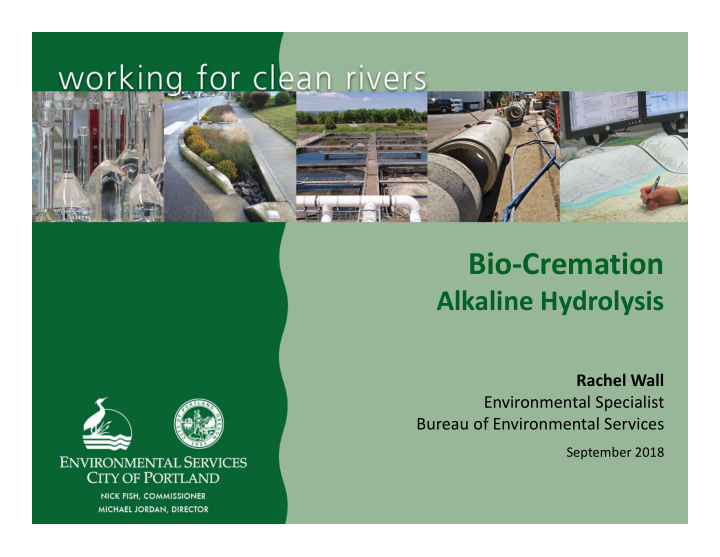



Bio ‐ Cremation Alkaline Hydrolysis Rachel Wall Environmental Specialist Bureau of Environmental Services September 2018
Outline Final Disposition Methods Traditional Burial, Fire Cremation, Bio ‐ cremation Process & Environmental Impacts Alkaline Hydrolysis Chemistry & History Portland Bio ‐ Cremation Facility Sampling, pretreatment and permitting Questions? Environmental Services l Presentation Title 2
Burial Highest Environmental Impact High Resource Demand 1.6M tons concrete 90,000 tons steel 30,000 tons wood 50% of Funeral Rites Slow Rate of Highest Consumer Decomposition Cost $7 ‐ 10,000 avg Environmental Services l Presentation Title 3
Embalming Fluid Formaldehyde + Glutaraldehyde + Methanol + Dye + Other Solvents Preserves Tissue Slows Decomposition US 5.3M gallons annually 800,000 gallons leach annually Environmental Services l Presentation Title 4
Fire Cremation Process Natural Gas Oven 1800 F for 2 ‐ 4 hrs 92 cubic meters 29 kW ‐ h electricity 700lbs of CO2 emissions Vaporized Metals Dioxins Halogenated Hydrocarbons Cremulator Environmental Services l Presentation Title 5
Fire Cremation ‐ Remains Dental Amalgam 50% Mercury Silver, Tin, Copper Dental Metals Most metals not re ‐ usable Removal before processing could lessen amount released Environmental Services l Presentation Title 6
Bio ‐ Cremation – Alkaline Hydrolysis Alkali + Heat + H20 + Pressure Breaks Bonds Destroys Pathogens & Prions, Genetic Material, Toxic Chemicals Originated in late 1800s Dead Livestock Nitrogen Rich Fertilizer Disposal of Research Animals NRC Standard 10CFR20 (Disposal by Release to Sanitary Sewer) Environmental Services l Presentation Title 7
Alkaline Hydrolysis – History Late 1800s – Dead Livestock Fertilizer 1900s – 10CFR20 Disposal of Research Animals 1990 – Findings on how to inactivate CJD 1993 – Hot Alkali Destroyed Prions 1995 – Mad Cow (BSE) Outbreak 2005 – Mayo Clinic 2011 – AH Commercially Available in FL Environmental Services l Presentation Title 8
Mad Cow (BSE) Bovine Spongiform Encephalopathy (BSE) Fatal Neurological Disease Sponge ‐ like legions on brain Spread by infected meat in cattle feed Incubation several years Creutzfeldt ‐ Jakob Disease (vCJD) in Humans Contracted by eating meat infected w/BSE Prion Caused Disease – Folded protein Environmental Services l Presentation Title 9
Bio ‐ Cremation – Alkaline Hydrolysis AKA Chemical Cremation, Water Cremation, Aquamation Water: 95% @90 ‐ 100 gallons Alkali: 5% Heat: @300 F Time: 3 ‐ 5 hrs Environmental Services l Presentation Title 10
Bio ‐ Cremation ‐ Process Steel Basket Inside Chamber Environmental Services l Presentation Title 11
Bio ‐ Cremation ‐ Remains Medical Implants Environmental Services l Presentation Title 12
Bio ‐ Cremation Remains Flame Cremation Bio-Cremation Environmental Services l Presentation Title 13
Bio ‐ Cremation ‐ Effluent Humans mostly H20 Sugars & Fats Nucleic Acids Amino Acids Build Proteins <300 gals/cycle Simple Organic Compounds Calcium Phosphate Environmental Services l Presentation Title 14
Initial Sample & Pretreatment Concerns (NaOH + KOH) + H20 BOD: 56,800mg/L TSS 180mg/L pH 12.2 High Zinc & Copper Frequency of Discharge FOG/Saponification Active Process Areas Environmental Services l Presentation Title 15
Saponification Triglyceride + (NaOH and KOH) Glycerol + Crude Soap Ester Hydrolysis Reaction NaOH = Hard Soap Lower cost KOH = Soft Liquid Soap Lubricant and detergent in sewer Environmental Services l Presentation Title 16
Course of Action Stop Discharging Clean Tank & Equipment Replace Brass Spigot w/Stainless Steel pH Adjust Prohibit NaOH (KOH only) Discharge Sample Port Increase co ‐ flush H20 pH Neutralization of 7 Resample Environmental Services l Presentation Title 17
Facility Resample & Findings Resample BOD: 12,200 mg/L TSS: 8,240 mg/L pH: 6.7 Zinc & Copper below limits No O/G method works for soap (fat) Effluent Resample No solids separator Environmental Services l Presentation Title 18
Bio ‐ Cremation ‐ Permitting Best Management Practices (BMP) based permit Detailed O&M Plan NaOH restriction pH adjustment w/mixing for distribution 5.0 – 11.5 Annual Reporting Batch and pH logs Waste hauling logs Outdoor Monitoring Access Structure Environmental Services l Presentation Title 19
Additional Considerations Variations in Machines and Methods Less caustic & Longer Exposure Time More Caustic & Less Time Less Caustic with Agitation Effluent Resample Environmental Services l Presentation Title 20
Cremation Type Comparison Bio ‐ Cremation Flame Cremation $300,000 ‐ $500,000 Start at $150,000 No air permit Air permit required Consumes 1/8 th the Vaporized Metals 700lbs CO2 per energy of flame deceased person Medical implants Toxic waste residue are recyclable Effluent can be used as fertilizer Environmental Services l Presentation Title 21
Questions? Rachel Wall Rachel.Wall@PortlandOregon.gov City of Portland Bureau of Environmental Services Environmental Services l Presentation Title 22
Recommend
More recommend